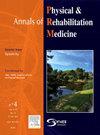Prolonged adaptation to a robotic prosthesis enhances gait symmetry: A case study in a transtibial amputee
IF 4.6
3区 医学
Q1 REHABILITATION
Annals of Physical and Rehabilitation Medicine
Pub Date : 2025-04-18
DOI:10.1016/j.rehab.2025.101981
引用次数: 0
Abstract
Purpose
This study evaluates the long-term biomechanical and energy efficiency effects of a high-torque, lightweight robotic ankle-foot prosthesis (RAF Pro) in a transtibial amputee, focusing on its potential to enhance gait symmetry and functionality.
Methods
A six-month longitudinal case study was conducted on a 51-year-old male transtibial amputee transitioning from a passive prosthesis to the RAF Pro. Comprehensive gait analyses, including motion capture and force plate assessments, were performed at four intervals: initial fitting, three months, four and a half months, and six months. The participant received continuous, tailored rehabilitation training throughout the study.
Results
Over the adaptation period, notable improvements were observed in plantarflexion during toe-off and in the coordination of hip and knee joint movements, contributing to enhanced gait symmetry. By the six-month mark, the subject achieved near-symmetrical gait mechanics with significantly reduced energy expenditure during walking, approaching the biomechanical efficiency observed in non-amputees.
Conclusion
This case study highlights the potential of long-term adaptive rehabilitation combined with advanced robotic prostheses to restore natural, energy-efficient gait mechanics in transtibial amputees. The findings emphasize the importance of a minimum six-month adaptation period for optimizing prosthetic function, offering valuable insights for personalized rehabilitation strategies and future prosthetic development.
长时间适应机器人假肢增强步态对称性:一个跨胫截肢者的案例研究
目的:本研究评估了高扭矩、轻型机器人踝足假体(RAF Pro)对经胫骨截肢者的长期生物力学和能量效率影响,重点关注其增强步态对称性和功能的潜力。方法对一名51岁男性经胫骨截肢者进行了为期6个月的纵向病例研究,该患者从被动假体过渡到RAF Pro。全面的步态分析,包括动作捕捉和力板评估,在四个间隔进行:初始拟合,三个月,四个半月和六个月。在整个研究过程中,参与者接受了持续的、量身定制的康复训练。结果在适应期,脱趾时足底屈曲和髋关节、膝关节运动协调性显著改善,步态对称性增强。6个月后,受试者达到了近乎对称的步态力学,行走时能量消耗显著减少,接近未截肢者的生物力学效率。结论:本案例研究强调了长期适应性康复与先进机器人假肢相结合的潜力,可以恢复经胫截肢者自然、节能的步态力学。研究结果强调了至少六个月的适应期对于优化假肢功能的重要性,为个性化康复策略和未来假肢的发展提供了有价值的见解。
本文章由计算机程序翻译,如有差异,请以英文原文为准。
求助全文
约1分钟内获得全文
求助全文
来源期刊

Annals of Physical and Rehabilitation Medicine
Medicine-Rehabilitation
CiteScore
7.80
自引率
4.30%
发文量
136
审稿时长
34 days
期刊介绍:
Annals of Physical and Rehabilitation Medicine covers all areas of Rehabilitation and Physical Medicine; such as: methods of evaluation of motor, sensory, cognitive and visceral impairments; acute and chronic musculoskeletal disorders and pain; disabilities in adult and children ; processes of rehabilitation in orthopaedic, rhumatological, neurological, cardiovascular, pulmonary and urological diseases.
 求助内容:
求助内容: 应助结果提醒方式:
应助结果提醒方式:


